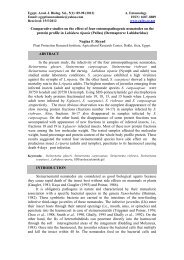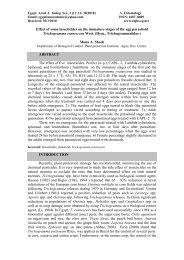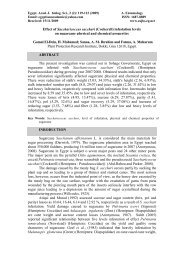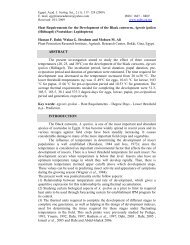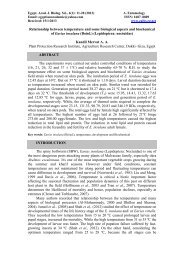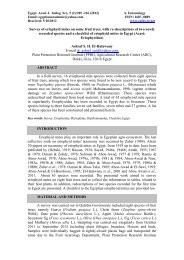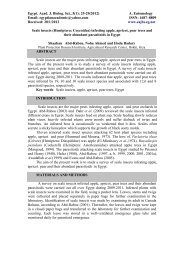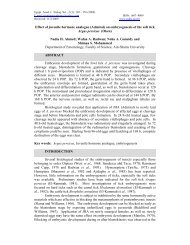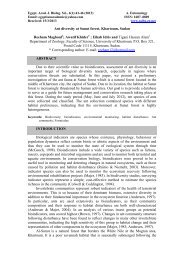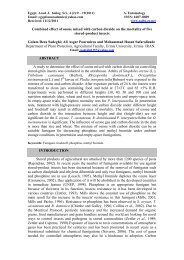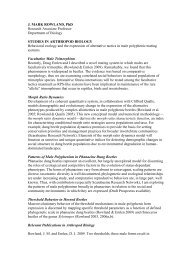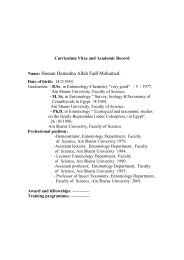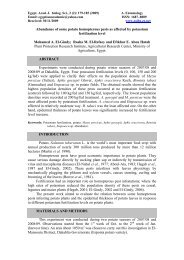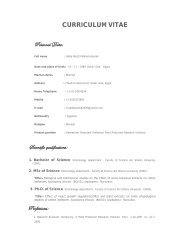Comparison of RAPD and PCR-RFLP markers for classification and ...
Comparison of RAPD and PCR-RFLP markers for classification and ...
Comparison of RAPD and PCR-RFLP markers for classification and ...
Create successful ePaper yourself
Turn your PDF publications into a flip-book with our unique Google optimized e-Paper software.
<strong>Comparison</strong> <strong>of</strong> <strong>RAPD</strong> <strong>and</strong> <strong>PCR</strong>-<strong>RFLP</strong> <strong>markers</strong> <strong>for</strong> <strong>classification</strong> <strong>and</strong> taxonomic studies 189<br />
volume. The digested fragments were resolved on a 2% agarose gel, visualized <strong>and</strong><br />
photographed using gel documentation system.<br />
Data analysis<br />
In both <strong>RFLP</strong> <strong>and</strong> <strong>RAPD</strong> assays, b<strong>and</strong>ing patterns <strong>of</strong> the samples were scored<br />
<strong>for</strong> the presence (1) or <strong>for</strong> absence (0) <strong>of</strong> each amplified b<strong>and</strong>. All <strong>RAPD</strong> assays were<br />
repeated thrice <strong>and</strong> only the reproducible b<strong>and</strong>s were scored. For considering a marker<br />
as polymorphic, the absence <strong>of</strong> an amplified product in at least one sample was used<br />
as a criterion. For genetic distance analysis, data sets were fed into the clustering<br />
program <strong>of</strong> SPSS (Version 14.0) <strong>and</strong> similarity matrix was determined using Jaccard's<br />
coefficient. Next, distance matrix (distance = 1 - similarity) was calculated. Based on<br />
similarity matrices using the unweighted pair group method analysis, STATISTICA<br />
program <strong>for</strong> Windows, 1995 (StatS<strong>of</strong>t, Inc., USA) was used to generate UPGMA<br />
dendrogram (Norusis, 1994). The Chi-square test was used to analyze the data<br />
obtained <strong>and</strong> differences were considered statistically significant if P< 0.05.<br />
RESULTS<br />
Levels <strong>of</strong> polymorphism<br />
B<strong>and</strong>ing patterns:<br />
Forty <strong>RAPD</strong> primers were used to amplify r<strong>and</strong>om sequences from the total<br />
DNA <strong>of</strong> the three ant species, C. maculatus, M. pharoensis <strong>and</strong> C. bicolor. All the<br />
primers gave clear b<strong>and</strong>ing patterns, as shown in Fig. (1).<br />
M 1 2 3 1 2 3 1 2 3 1 2 3 1 2 3<br />
Fig. 1: Representative 2% agarose gels <strong>of</strong> <strong>RAPD</strong>-<strong>PCR</strong> patterns generated from three<br />
ant species, C. maculatus, M. pharoensis <strong>and</strong> C. bicolor using <strong>for</strong>ty arbitrary<br />
primers OPA <strong>and</strong> OPB. Lane M: DNA marker 100 bp Ladder, lane 1: C.<br />
maculatus, lane 2: C. bicolor <strong>and</strong> lane 3: M. pharoensis.<br />
An average <strong>of</strong> 7.5 b<strong>and</strong>s per primer were obtained <strong>for</strong> one amplification <strong>and</strong> a<br />
total <strong>of</strong> 100 b<strong>and</strong>s per species were compared among the 3 species. In <strong>RFLP</strong> assay, an<br />
average <strong>of</strong> 5 b<strong>and</strong>s were observed <strong>for</strong> each reaction (Fig. 2) <strong>and</strong> 7 b<strong>and</strong>s per species<br />
were obtained with four restriction enzymes in 36 <strong>RFLP</strong> reactions. <strong>RAPD</strong> analysis<br />
revealed that the highest average percentage <strong>of</strong> common (monomorphic) b<strong>and</strong>s<br />
(78.1%) was observed within C. maculatus. Meanwhile, the highest average<br />
percentage <strong>of</strong> polymorphic b<strong>and</strong>s (45.5%) was observed within M. pharoensis (Table 1).



